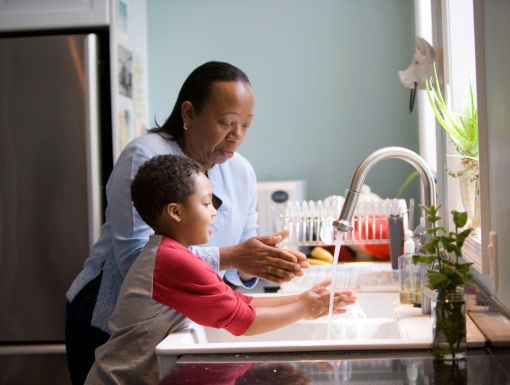
Coronavirus: Helping Children Deal with Anxiety
COVID-19 has dramatically altered the way we work, socialize and live. The closure of schools creates an additional stress for parents as it creates childcare concerns and leaves parents scrambling to maintain a sense of normalcy for the child. For some children, this is a very uncertain and anxious time. Here are a few behaviors that children may display when they are anxious, and strategies to help parents support their children during this time.
Behaviors to watch for by age group:
Children age 2 through preschool experiencing anxiety may display excessive clinging, cowering or hiding in a corner, withdrawal from activities or regression with bed wetting and thumb sucking. They may also display repetitive play.
School-age children tend to report stomachaches, nightmares and headaches and may exhibit behavior changes. For example, a typically withdrawn and passive child may start to act out more, whereas a typically uninhibited child may become withdrawn.
Children in early adolescence tend to report more physical stress, such as nausea, headaches, sleep disturbance and crying spells.
Adolescent children also report physical stress, but may also engage in more risk-taking behaviors.
Strategies to support your child
1. Harness the past:
Parents, think about a stressful time your family has gone through. How did you get through it? What coping strategies did you and your family use? If your child is able to understand the conversation, remind your child of the stressful or difficult time and how you got through it. Remind your child of the coping strategies and how things turned out ok, or maybe even better. Discuss the lessons that were learned from that challenging time.
The question now becomes: How can you take the lessons learned from that time and apply it to this challenging time? For adolescent children, this is a great way to discuss life lessons and that when people are challenged, it is our choices and coping strategies that get us through it.
2. Practice coping techniques
If your child is displaying any of the anxious behaviors listed above, coach your child to name the bodily sensations they are experiencing. Have them identify the bodily response. Is it a stomachache, headache, muscle tension, racing thoughts, etc? Then, help them to identify the emotion. Are they scared, anxious and/or sad? It may be very difficult for your child to label the emotion. You can list possible choices of emotions and see if they pick one or two. Whether or not they can label the emotion, it is important to discuss and develop a list of coping strategies. For example, they can take a deep breath and count to 3 or 5, call a friend or family member, write or draw about how they feel, or practice progressive muscle relaxation.
3. Address uncertainty:
If your child is worried about their own or their parents’ safety, explain to your child all the precautions you take to stay safe. Explain how you wear protective clothing, wash your hands and practice social distancing. Parents are encouraged to provide reassurance, stability and comfort.
4. Create structure
The uncertainty of the time, the lack of control and the decreased structure of the day due to the school and community closures adds to the sense of anxiety and panic. Create a schedule for the day that closely follows the school schedule. Also, maintain healthy eating habits and sleep schedules. Keeping a routine helps rebuild a sense of normalcy and control. It is also helpful for children to re-establish a sense of control over little things. Parents can help their child regain control by making them feel like they are part of the team to prevent the spread of COVID-19. Parents should provide children with responsibilities or chores such as cleaning their toys, tidying their bedroom, cleaning their sink in the bathroom, etc. Give the children developmentally appropriate tasks to help keep the home sanitary and clean.
5. Reduce exposure to possibly fear-inducing news
Limit the exposure to news stations discussing the COVID-19 outbreak. Repeated exposure to the news can increase feelings of anxiety. While it is great for your child to be informed, it is best that the majority of the information is coming from a source like you, the parent. As a parent, you know what your child can best understand and tolerate and you can adjust the message to be more kid-friendly.
Children look to their parents to see how to respond. Be mindful of what you are saying and doing in front of your children and model good coping strategies. Be aware of the verbal and non-verbal message you are sending your children.
The Michael R. Boh Center for Child Development is here as a resource to you and your children. Click hereto contact us if you need support.
For more information about COVID-19, please visit ochsner.org/coronavirus.
The information in this blog post is accurate at the time of publication. However, as the situation surrounding COVID-19 continues to change, it's possible that information has changed since being published. While Ochsner Health is trying to keep our blog posts as up-to-date as possible, we also encourage readers to stay informed on news and recommendations by using the CDC website.


